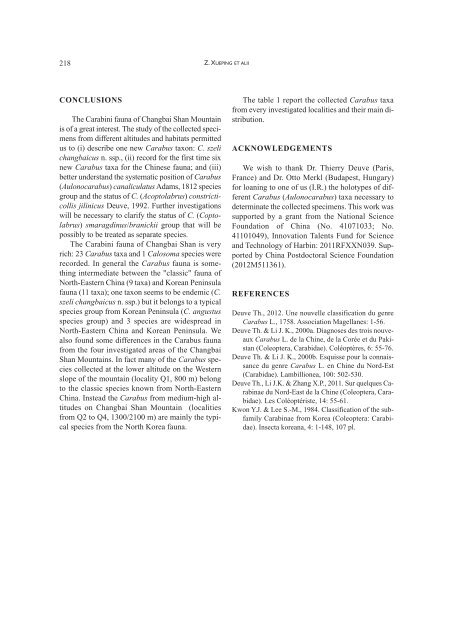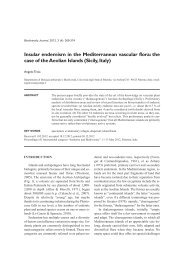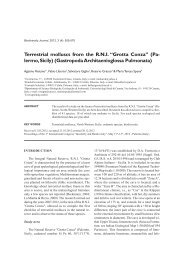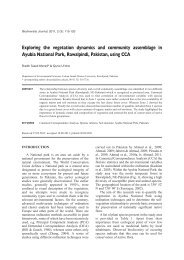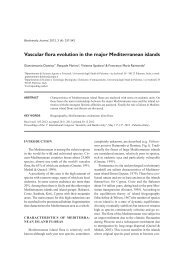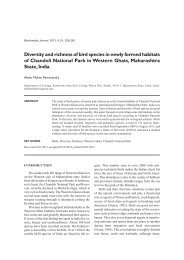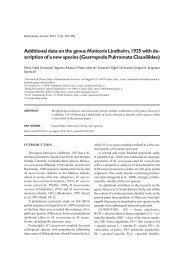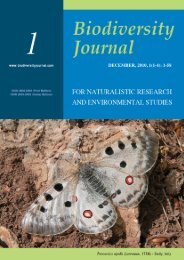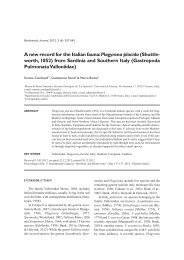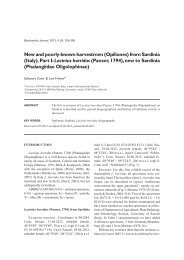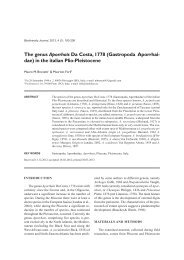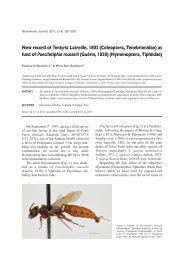Zhang Xueping, Ivan Rapuzzi, Gao Meixiang, Li Jingke ...
Zhang Xueping, Ivan Rapuzzi, Gao Meixiang, Li Jingke ...
Zhang Xueping, Ivan Rapuzzi, Gao Meixiang, Li Jingke ...
Create successful ePaper yourself
Turn your PDF publications into a flip-book with our unique Google optimized e-Paper software.
218Z. XUEPING ET ALIICONCLUSIONSThe Carabini fauna of Changbai Shan Mountainis of a great interest. The study of the collected specimensfrom different altitudes and habitats permittedus to (i) describe one new Carabus taxon: C. szelichangbaicus n. ssp., (ii) record for the first time sixnew Carabus taxa for the Chinese fauna; and (iii)better understand the systematic position of Carabus(Aulonocarabus) canaliculatus Adams, 1812 speciesgroup and the status of C. (Acoptolabrus) constricticollisjilinicus Deuve, 1992. Further investigationswill be necessary to clarify the status of C. (Coptolabrus)smaragdinus/branickii group that will bepossibly to be treated as separate species.The Carabini fauna of Changbai Shan is veryrich: 23 Carabus taxa and 1 Calosoma species wererecorded. In general the Carabus fauna is somethingintermediate between the "classic" fauna ofNorth-Eastern China (9 taxa) and Korean Peninsulafauna (11 taxa); one taxon seems to be endemic (C.szeli changbaicus n. ssp.) but it belongs to a typicalspecies group from Korean Peninsula (C. angustusspecies group) and 3 species are widespread inNorth-Eastern China and Korean Peninsula. Wealso found some differences in the Carabus faunafrom the four investigated areas of the ChangbaiShan Mountains. In fact many of the Carabus speciescollected at the lower altitude on the Westernslope of the mountain (locality Q1, 800 m) belongto the classic species known from North-EasternChina. Instead the Carabus from medium-high altitudeson Changbai Shan Mountain (localitiesfrom Q2 to Q4, 1300/2100 m) are mainly the typicalspecies from the North Korea fauna.The table 1 report the collected Carabus taxafrom every investigated localities and their main distribution.ACKNOWLEDGEMENTSWe wish to thank Dr. Thierry Deuve (Paris,France) and Dr. Otto Merkl (Budapest, Hungary)for loaning to one of us (I.R.) the holotypes of differentCarabus (Aulonocarabus) taxa necessary todeterminate the collected specimens. This work wassupported by a grant from the National ScienceFoundation of China (No. 41071033; No.41101049), Innovation Talents Fund for Scienceand Technology of Harbin: 2011RFXXN039. Supportedby China Postdoctoral Science Foundation(2012M511361).REFERENCESDeuve Th., 2012. Une nouvelle classification du genreCarabus L., 1758. Association Magellanes: 1-56.Deuve Th. & <strong>Li</strong> J. K., 2000a. Diagnoses des trois nouveauxCarabus L. de la Chine, de la Corée et du Pakistan(Coleoptera, Carabidae). Coléoptères, 6: 55-76.Deuve Th. & <strong>Li</strong> J. K., 2000b. Esquisse pour la connaissancedu genre Carabus L. en Chine du Nord-Est(Carabidae). Lambillionea, 100: 502-530.Deuve Th., <strong>Li</strong> J.K. & <strong>Zhang</strong> X.P., 2011. Sur quelques Carabinaedu Nord-East de la Chine (Coleoptera, Carabidae).Les Coléoptériste, 14: 55-61.Kwon Y.J. & Lee S.-M., 1984. Classification of the subfamilyCarabinae from Korea (Coleoptera: Carabidae).Insecta koreana, 4: 1-148, 107 pl.


